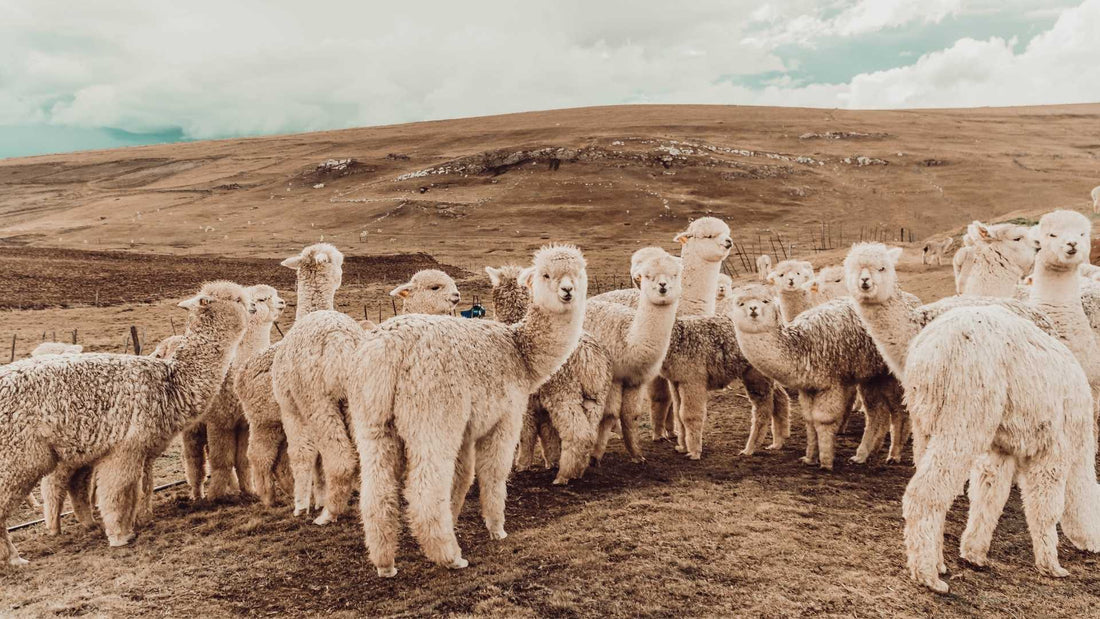
10 Things You Didn’t Know about Alpacas
Share
Get a taste of the gods, all while feeling like a sustainable Queen! Check out our list of 10 Things You Didn’t Know about Alpacas!
Alpaca: Fibre of the Gods
In ancient Peru, sometime around the 15th and 16th centuries, the Inca civilization flourished, dominating much of South America. Being one of the largest empires in recorded history, the Incas ruled the Southern hemisphere with great power and influence.
The alpaca, domesticated over 6000 years ago, represents a unique South American textile tradition.
In Incan history, alpaca was known as the "fibre of the gods." It was reserved for royalty.
Today, we work with a family of Indigenous artisans who use this extraordinary alpaca fibre to create pieces of unparalleled luxury.
Each piece is brought to you directly from their household workshop.
As an essential textile to the sustainable products Pokoloko offers, it’s important to understand the resource we rely on.
So here are 10 more fun facts you probably didn’t know about these adorable llama-lookalikes!

1. Alpacas are Ancient Status Symbols
The Incan nobles demonstrated wealth by the number of alpacas they owned. They would flaunt their garments woven with alpaca fleece.
2. Alpacas are Environmentalists
Their softly padded feet leave terrain undamaged. As they graze, alpacas only nibble the top of pasture grass, rather than uprooting it.

3. Alpacas are Lovers
As herd animals, their social structure requires alpacas to live with others of their kind. An alpaca will become lonely, and may even sicken and die, if isolated. Therefore, they cannot live alone.
4. Alpacas Share a Bathroom
Alpacas use a communal dung pile to do their business, in an area far removed from where they graze.
Fun fact: Some alpacas have actually been successfully house-trained!
5. Alpacas are Therapeutic
The huggable alpaca’s calm and happy disposition makes them a favourite for animal-based therapies. A typical example of an alpaca-based therapeutic activity involves walking them on a leash. :)
6. They Don’t Bite
Alpacas have a jutted out lower jaw and a hard upper dental pad. But they have no proper teeth, horns, hooves or claws. That’s why these adorable animals always look like they have an underbite!
7. But They Can Spit
Rarely, and if provoked, an alpaca can blow air and saliva at an aggressor. They can project acidic stomach contents up to 10 feet away.
8. Celebrities Love the Alpaca Style
Arnold Palmer loved alpaca. Many celebrities have promoted alpaca’s classic quality and style. Other notables include Frank Sinatra, Bing Crosby and Nicole Kidman.
9. Alpacas Are Musicians
Alpacas vocally communicate with a melodic hum to express a spectrum of emotions, from curiosity to mourning. Their emotional intelligence lends itself well to the argument that alpacas make for great therapeutic companions.

10. Alpacas Are Multi-Coloured
These soft and friendly animals come in 22 recognized natural colours and over 300 shades. Sinatra's personal favourite:orange… we kid you not!
“DID YOU KNOW? Alpacas are vegetarian! Their grass-fed diet makes them a very sustainable farming resource.”
Alpacas are Sustainable to Raise
A 125lb alpaca only eats about 2lbs a day in fuel. Their diet consists mainly of grass, however they are also known to snack on wood, leaves and bark. This plant-based diet makes alpaca-farming a very sustainable option when doing fair trade business.

Our Chemical-Free Alpaca Dryer Balls
Experience the Fibre of the Gods for yourself! Try adding 3 of our Alpaca Dryer Balls in with your next load of laundry, and commit to an eco-friendly alternative when nixing those toxic dryer sheets.


4 comments
This is incredible
Thanks for these facts – makes me want to return to Peru!!!!
Fascinating information! I was quite ignorant about them!!
Would you consider carrying hats, scarves and mitts for youths? I would purchase 2 sets per kid. Maggie likes teal/aqua colours and Keira loves purple/pinks.